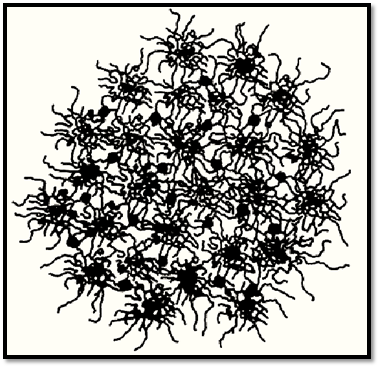


 النبات
النبات
 الحيوان
الحيوان
 الأحياء المجهرية
الأحياء المجهرية
 علم الأمراض
علم الأمراض
 التقانة الإحيائية
التقانة الإحيائية
 التقنية الحيوية المكروبية
التقنية الحيوية المكروبية
 التقنية الحياتية النانوية
التقنية الحياتية النانوية
 علم الأجنة
علم الأجنة
 الأحياء الجزيئي
الأحياء الجزيئي
 علم وظائف الأعضاء
علم وظائف الأعضاء
 الغدد
الغدد
 المضادات الحيوية
المضادات الحيوية|
Read More
Date: 3-1-2016
Date: 10-5-2016
Date: 16-11-2020
|
Casein
Several kinds of phosphoproteins collectively called casein constitute 80% of the protein of cow's milk and 40% of that of humans. Casein is made up of all 20 kinds of amino acids, which is an important characteristic from a nutritional point of view. Skim milk, which is the milk left after the cream is removed, is brought to pH 4.7 to form a precipitate that contains the casein. The supernatant is called whey and contains 20% of the total protein. Electrophoresis at alkaline pH separates casein into the a, b, and g fractions. The a fraction is further separated into as1 and as2, the common subscript s signifying sensitivity to precipitation by the addition of calcium and k-casein. Both as-casein and b-casein are precipitated with Ca++, whereas k-casein is not. In milk, these caseins constitute micelles (calcium caseinate-phosphate complex) of a diameter in the range of 30 to 300 nm. The a- and b- caseins are rich in phosphate, mainly in the form of O-phosphoserine residues, and they form a calcium complex that is not soluble, but precipitated. When surrounded by the hydrophilic parts of k-casein in milk, however, it is soluble as large complexes. The g-casein fraction is a heterogeneous mixture primarily of proteolytic fragments of b-casein.
Bovine b-casein contains 209 amino acid residues (with a molecular weight of 23,600) and is very hydrophobic. Five phosphoserine residues are found in the N-terminal region. In milk, the phosphoserine residues are associated with Ca++ ions, forming calcium caseinate. b-casein and its partial hydrolysis products present in milk do not have definite three-dimensional structures. They are considered to have a random coil structure that is easily digestible, an advantage of casein as a nutritional protein. The relative casein composition of bulk milk is given in Table 1.
Table 1. Average Casein Composition of Bovine Bulk Milk Samples

The fourth stomach of ruminating animals (abomasum) contains a proteolytic enzyme called chymosin, which liberates a glycopeptide from k-casein at neutral pH. The remaining molecule, called para-casein, reacts with Ca++ and then forms an insoluble curd, the source of cheese. The enzyme preferentially cleaves the peptide bond between Phe105-Met106 of k-casein to produce para-k-casein. Humans do not have chymosin, but pepsin in the stomach converts k-casein to para-casein to start the digestion of milk in the infant stomach. Chymosin and pepsin are structurally related.
The casein micelle has a complex structure, and the relative disposition of the four subspecies of casein, and especially that of k-casein, has long been the focus of discussion. Since chymosin preferentially digests k-casein, this casein is thought to be on the periphery of the micelle. Recent electron micrographs of variously treated micelles show granular structures covering the surface, prompting a suggestion that a casein micelle is composed of smaller-sized submicelles. The idea of a submicellar structure has actually been a long standing one from reconstitution experiments, and by incorporating various observations, a currently accepted model of casein micelles is presented by Holt (1), as reproduced in Figure 1.

Figure 1. Structural model of casein micelles. Reproduced from (1) (Fig. 13, p. 108) with permission.
Secretory vesicles of casein micelles are found abundantly in mammary secretory cells. After the casein proteins are synthesized, they undergo O-glycosylation and phosphorylation before being secreted. These changes occur in concert with lactose synthesis by the enzyme known as lactose synthetase. All the enzymes involved in glycosylation, phosphorylation, and lactose synthesis can tolerate Ca++ concentrations in the range of 1 mM. Accumulation of Ca++ in the mammary gland cell, together with phosphorylation of some serine residues, is necessary for the formation of casein micelles.
References
1. C. Holt (1992) Structure and stability of bovine casein micelles, Adv. Prot. Chem. 43, 63–151.



|
|
|
|
لخفض ضغط الدم.. دراسة تحدد "تمارين مهمة"
|
|
|
|
|
|
|
طال انتظارها.. ميزة جديدة من "واتساب" تعزز الخصوصية
|
|
|
|
|
|
|
عوائل الشهداء: العتبة العباسية المقدسة سبّاقة في استذكار شهداء العراق عبر فعالياتها وأنشطتها المختلفة
|
|
|